on constructs and 500 pmol PIX-specific siRNA and cultured cells for 48 h. GFP Duplex I manage siRNA (GE Healthcare Dharmacon Inc.) was utilised as unfavorable control. Upon 48h of PIX down-regulation, we performed EGFR steady-state trafficking assays (Fig 7B) at the same time as EGFR pulse-chase recycling assays (S4 Fig) as described above.
COS-7 and CHO cells have been cultivated on coverslips and, if needed, transiently transfected with expression constructs. To track EGF internalization, COS-7 cells have been serum starved for 24 h and stimulated with 25 ng/ml fluorescently labelled EGF in starvation medium for 15 or 60 min followed by an acidic wash to remove non-internalized and recycled EGF from plasma membrane standing EGFR (Fig 6C). To analyse the morphology of EEA-positive vesicular structures (Fig 3C), serum-starved COS-7 cells have been pulsed with 25 ng/ml EGF for 30 min at 37, rinsed with PBS and chased in starvation medium for 30 min. To examine the cellular distribution of EGFR, CHO cells transfected with control siRNA (siRNAcontrol) or siRNA certain for PIX (siRNA1PIX) (Fig 7C) and Flp-In-CHO stably expressing CAT or PIXWT (Fig 6B) have been utilised. Co-transfection of an RFP expression vector served as manage for productive siRNA transfection of CHO cells. Each, siRNA transfected CHO cells and stably expressing Flp-In-CHO have been transiently transfected with EGFR constructs, serum starved overnight and stimulated with EGF for 15 or 60 min. Subsequently, cells were rinsed with PBS, fixed with 4% paraformaldehyde (Sigma-Aldrich, Taufkirchen, Germany) in PBS and washed 3 times with PBS. After treatment with permeabilization/blocking answer (2% BSA, 3% goat serum, 0.5% Nonidet P40 in PBS) cells had been incubated in antibody resolution (3% goat serum and 0.1% Nonidet  P40 in PBS) containing appropriate primary antibodies. Cells were washed with PBS and incubated with CY5 Fluorophore-conjugated secondary antibodies (Alexa Fluor Dyes; Life Technologies, Darmstadt, Germany) in antibody resolution. Right after comprehensive washing with PBS cells were embedded in mounting option (25% Mowiol 48 in PBS mixed with 5% Propyl gallate in PBS/Glycerol within a ratio of 4:1) on microscopic slides. Cells had been examined with a Leica DMIRE2 confocal microscope equipped with an HCX PL APO 63x/1.32 oil immersion objective lens.
P40 in PBS) containing appropriate primary antibodies. Cells were washed with PBS and incubated with CY5 Fluorophore-conjugated secondary antibodies (Alexa Fluor Dyes; Life Technologies, Darmstadt, Germany) in antibody resolution. Right after comprehensive washing with PBS cells were embedded in mounting option (25% Mowiol 48 in PBS mixed with 5% Propyl gallate in PBS/Glycerol within a ratio of 4:1) on microscopic slides. Cells had been examined with a Leica DMIRE2 confocal microscope equipped with an HCX PL APO 63x/1.32 oil immersion objective lens.
We made use of BrdU Cell Proliferation Assay Kit (Cat. No. #6813, Cell Signaling Technologies, Danvers, MA, USA) to investigate proliferation in steady CHO cell lines. 12,500 cells have been seeded in one hundred l starvation medium (F12 medium, 0.1% FBS, one hundred U/ml penicillin and 100 mg/ml streptomycin) and incubated at 37 for 24h hours to synchronize the cell cycle. Medium was then changed to 1x BrdU remedy prepared in common growth medium (F12 medium, 10% FBS, one hundred U/ml penicillin and 17764671 one hundred mg/ml streptomycin) and incubated for 6h at 37 to induce proliferation and incorporation of BrdU through S-Phase. Subsequent process was performed according to the manufacturer’s guidelines. The BrdU incorporation was measured at 450 nm using the Epoch Microplate Spectrophotometer (BioTek, Bad Friedrichshall, Germany) applying the Gen5 Information Analysis application (BioTek, Undesirable Friedrichshall, Germany).
Signals on autoradiographs from three to six independent experiments were quantified by densitometric evaluation applying the ImageJ computer software (NIH; http://rsb.info.nih.gov/ij/index.html). Relative amounts of PIX::c-Cbl complexes (Fig 2A) and of PIX and Cbl (Fig 2B and 2C) have been determined as described in the figure legend. Tw
